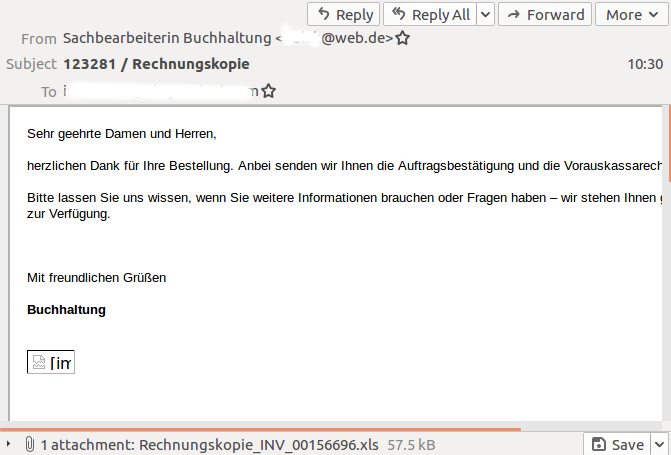German Dridex spam campaign is unfashionably large
This research was performed by Martijn Grooten, Peter Karsai and Ionuț Răileanu.
On this blog we have regularly reported on the tendency among malicious spam campaigns to be smaller in scale and more targeted, thus improving their chances of evading spam filters ─ indeed, we described exactly this strategy two days ago when writing about Emotet.
However, there are always exceptions to such trends: yesterday morning we spotted two fairly large spam campaigns with Excel attachments. The campaigns, which were in German, were everything that most malspam campaigns are not: large in scale, sent to many older spam traps, and with the same attachment shared by all emails in the campaign.
Such a campaign can be reasonably successful for the spammer if emails are sent in a short burst, allowing them to stay ahead of the email security products. Indeed, we noted that some of the emails, especially the earlier ones, were missed by some of the products in our test lab.

The emails were all written in German and promised a bill in the attachment, which was an Excel file.
The following analysis is based on the attachment seen in the first campaign (SHA256: e108ca0f32af1ad5d73a8be3d8b954fd74a9187fe3ff5debb5007dc8ec1c3ce4).
The go-to tool for manual analysis of (potentially) malicious documents is Didier Stevens’ oledump.py. Running python oledump.py Rechnungskopie_INV_00156696.xls showed that the file consists of 18 streams (the upper case M next to stream 12 indicates it contains VBA macros):
The macros were unpacked using the command python oledump.py Rechnungskopie_INV_00156696.xls -s 12 -v. We found dozens of lines of obfuscated VBA code. Though the primary goal of obfuscation is to evade detection, it also acts to frustrate researchers and it isn’t immediately clear what the code does. A few things stand out though.
First, there is code that is run when the macro is activated that checks for one of five locales ─ if the locale is not set to one of these values the execution of the program ends:
Unsurprisingly, given the language of the campaign, these locales correspond to five German language locales ─ those for Switzerland (2055), Luxembourg (4103), Liechtenstein (5127), Germany (1031) and Austria (3079).
The second notable thing is that the core function refers to several cells in the spreadsheet.
(The function tapo is defined to be a copy of Cell, which reads the content of a cell.)
In white and very small font, the cells contain strings that are used to generate a shell command. The generation of this command is rather cumbersome by hand, but a debugger like ViperMonkey can help us automate part of this talk. It helped us find the following shell command:
The command decodes a base64 string and then decompresses it, only to result in a PowerShell script:
This one is relatively easy to de-obfuscate and downloads a payload from the URL https://nedronog[.]com/4.php, followed by an argument. This payload is locally decoded to a PE file that is slightly different for every download and that we confirmed to be Dridex. Dridex is a banking trojan, which explains why the campaign is targeted to one particular language.
We did not analyse the Dridex variant itself, but noted that the PowerShell script randomly chooses between two ways to execute the malware: a DCOM-based method and a classic one using rundll32.
6609dccb0efd4771150270be90d6c1f3ced588ba71e6274bfd23cede26c987f4 (attachment)
e108ca0f32af1ad5d73a8be3d8b954fd74a9187fe3ff5debb5007dc8ec1c3ce4 (attachment)
5e0a767efa0b8132a49d341eb0cc544ea89f19882ee14fd1c0368b4ca98c8e14 (Dridex; note that a different payload is generated each time)
nedronog[.]com
47.254.236.15
xxxxxx / Rechnungskopie
Bestätigung / Rechnung xxxxxx – 1 : 05.11.2019
Kopie der Rechnung
Original-Rechnung
Rechnung Oktober 2019
outertext
https://www.virusbulletin.com/rss